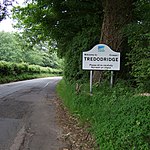The A48 is a trunk road in Great Britain running from the A40 at Highnam, 3 miles (4.8 km) west of Gloucester, England, to the A40 at Carmarthen, Wales. Before the Severn Bridge opened on 8 September 1966, it was a major route between England and South Wales. For most of its route, it runs almost parallel to the M4 motorway. During times of high winds at the Severn Bridge, the A48 is used as part of the diversion route and is still marked as a Holiday Route.
From Gloucester, the A48 runs through the villages of Minsterworth, Westbury-on-Severn, connects to a link road to Cinderford in the Forest of Dean then through Newnham, Blakeney and since 1995, bypassing Lydney on the west bank of the River Severn. It crosses the England–Wales border at Chepstow and continues westwards close to the South Wales coast passing Newport, Cardiff, Cowbridge, Bridgend, Pyle, Port Talbot, Neath and Swansea, before terminating at the junction with the A40 near the centre of Carmarthen.
There is a motorway section (the A48(M)) which is a spur from the M4 running from junction 29 on the west side of Newport. The A48(M) has no junction options at either end; it leads to limited-access junctions. Near the east of Cardiff, at St Mellons, it ends by flowing onto the A48 (Eastern Avenue) and through Cardiff. It is 2 miles (3.2 km) long and is a 2-lane motorway throughout its length. At St Mellons it runs continuously into a further 6 miles (9.7 km) of the dual-carriageway A48, which also features (albeit narrow) hard shoulders. The original A48 continues to link Newport and Cardiff.










